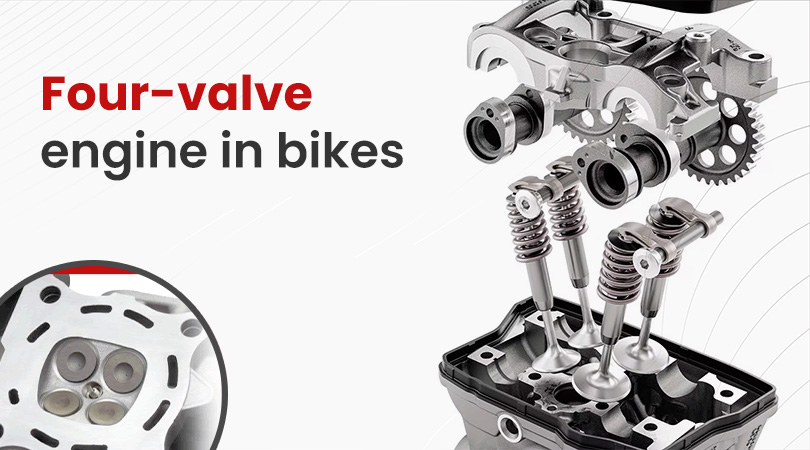Four-valve engine configurations, nowadays a common feature among motorcycles, have changed the face of performance efficiency and riding feel. As far as tech goes, there is a definite advancement over the traditional two-valve structure. It has several valid advantages that brought it ahead in the scheme of things.
1. Enhanced Breathability and Air Flow
A primary benefit of a four-valve engine is that its flow characteristics are better. Most often, it would contain two inlets and two exhaust valves because each cylinder has four valves in it. In most scenarios, the breathing efficiency can be noticeably higher in a four-valve engine than in its two-valve counterparts.
More air and fuel can fill the combustion chamber, along with faster exhaust gas being able to get out owing to this configuration, whose total valve area is being used.
This translates directly to better volumetric efficiency. This means that the engine can take in more air-fuel mixtures during each intake stroke and eliminate exhaust gases entirely during the exhaust stroke. This has the performance benefits of several improved breathing capabilities: higher power output, better throttle response, and improved engine efficiency overall.
2. Improved Engine Performance and Power Delivery
Four-valve-engine bikes generally produce more power over a wider rev range than two-valve-engine bikes. More valves allow for much tighter control of air and fuel mixture. This enables the engineers to optimize the combustion chamber design and the timing of the valves. Here are the performance benefits:
- Higher Potential Horsepower: The increased airflow potential directly contributes to higher power output.
- More Efficient Volumetrics: More air and fuel can be added into each combustion cycle.
- Improved Torque Characteristics: Four-valve allows more lumped torque through across varied engine speeds.
- Better High RPM Perf: Four-valve engine design enables breathing easier at higher rotational speeds.
3. Thermal Management and Efficiency
The four valves allow for a lot of advantages in thermal management. Using more valves, there is an even distribution of heat on the cylinder head. Thus, localized hot spots are reduced, and good cooling of the engine is guaranteed. The smaller individual valve sizes also imply that each valve needs to undergo less thermal stress; therefore, it enhances the life and reliability of the engine.
Additionally, fuel efficiency is an added bonus due to efficient combustion. Proper combustion, plus proper mixing of air and fuel, ensures that less dangerous emissions and waste enter the environment. In all seriousness, it is a rather major deal in this time of increased awareness and constantly more stringent pollution requirements.
4. Valve Train Flexibility with Advanced Engineering
The four-valve designs allow designers much more flexibility when making complex valve train systems. That way, opportunities for higher technologies are created, such as Variable Valve Timing (VVT), Multi-stage intake systems, and much more sophisticated cam profile designs and easier integration of advanced electronic engine management systems.
These technologies can further improve engine performance. This makes it smooth for riders, fuel-efficient and improves general riding characteristics.
5. Lower Mechanical Stress
Contrary to initial assumptions, four-valve engines come with much less mechanical stress than their two-valve counterparts. The distribution of air and exhaust flow across four smaller valves instead of two larger ones; the individual component experiences reduced mechanical load. This results in:
- Less wear and tear.
- Less mechanical fatigue.
- Even more possible longevity of the engine.
- More consistent performance within the lifecycle of the engine.
6. Versatility Across Motorcycle Types
This four-valve technology has even been advantageous across different motorcycle ranges:
- Sports Bikes- Sports bike maximizes at high RPMs and achieves maximum power output.
- Touring Motorcycles- Offer smooth, consistent power output and better fuel efficiency.
- Adventure Bikes- Robust performance in all types of road conditions
- Urban Commuter- Responsive throttle and great fuel economy.
7. Fine Acoustics and Cruising
A quality that goes amiss is that the four-valve power unit is capable of imparting an engine sound with high degrees of sophistication. Progress from the standpoint of valve actions and combustion tends to imbue an engine noise above the level of mere smoothness or melodicity that is more than enough for bikers anywhere in the world.
8. Technological Change and Market Trends
Four-valve technology has widely become the norm for most motorcycle manufacturers as a result of proven benefits and ongoing development of production methods that lower the production cost of four-valve engines.
9. Possible limitations and considerations
While there are many positive benefits to four-valve engines, there are also disadvantages. The main disadvantages include increased production costs, more complicated services, and possibly expensive repair jobs. However, all those disadvantages have been negated by the progress of manufacturing technology and materials science.
In summary
Probably the biggest innovation in motorcycle engine design is the four-valve engine. Since these engines supply better airflow, better thermal management, more performance, and more technical freedom, the riding experience has changed leaping bounds.
Four-valve engines will probably be much more complicated as motorcycle technology keeps advancing.
They are possibly incorporating advanced technologies like electrification and hybrid systems. For riders seeking the best performance, efficiency, and riding pleasure, four-valve engines definitely provide an exciting package that still moves the limits of two-wheeled transportation.
Briefly stated you are sure to enjoy increased power delivery, better breathing, enhanced efficiency, and a more premium riding experience. Four-valve engine technology offers major benefits in improving all dimensions of motorcycle performance regardless of whether one is a sport bike enthusiast, daily commuter, or tourer.




































